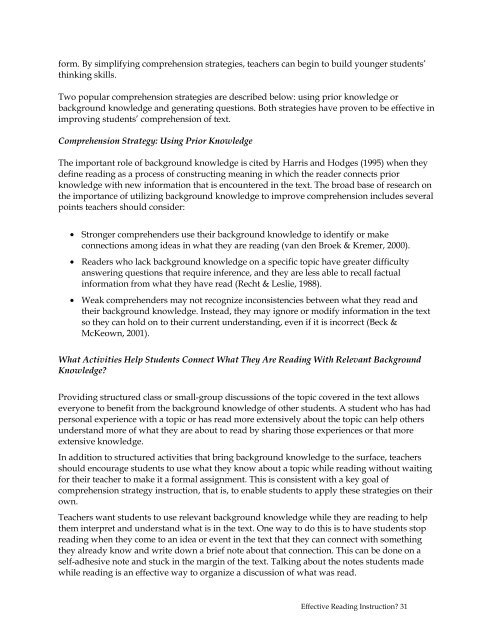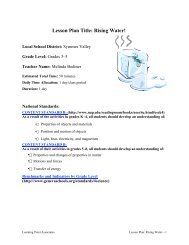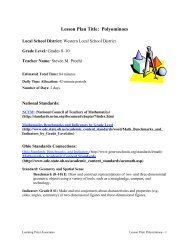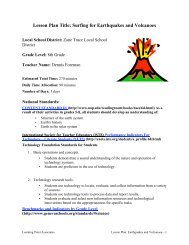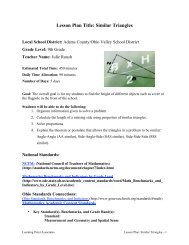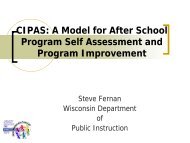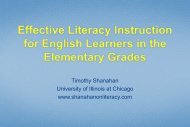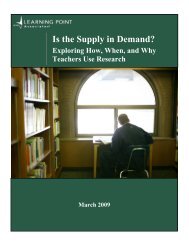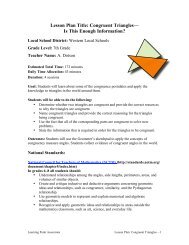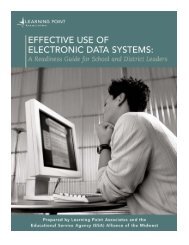A Closer Look at the Five Essential Components - Learning Point ...
A Closer Look at the Five Essential Components - Learning Point ...
A Closer Look at the Five Essential Components - Learning Point ...
You also want an ePaper? Increase the reach of your titles
YUMPU automatically turns print PDFs into web optimized ePapers that Google loves.
form. By simplifying comprehension str<strong>at</strong>egies, teachers can begin to build younger students’<br />
thinking skills.<br />
Two popular comprehension str<strong>at</strong>egies are described below: using prior knowledge or<br />
background knowledge and gener<strong>at</strong>ing questions. Both str<strong>at</strong>egies have proven to be effective in<br />
improving students’ comprehension of text.<br />
Comprehension Str<strong>at</strong>egy: Using Prior Knowledge<br />
The important role of background knowledge is cited by Harris and Hodges (1995) when <strong>the</strong>y<br />
define reading as a process of constructing meaning in which <strong>the</strong> reader connects prior<br />
knowledge with new inform<strong>at</strong>ion th<strong>at</strong> is encountered in <strong>the</strong> text. The broad base of research on<br />
<strong>the</strong> importance of utilizing background knowledge to improve comprehension includes several<br />
points teachers should consider:<br />
• Stronger comprehenders use <strong>the</strong>ir background knowledge to identify or make<br />
connections among ideas in wh<strong>at</strong> <strong>the</strong>y are reading (van den Broek & Kremer, 2000).<br />
• Readers who lack background knowledge on a specific topic have gre<strong>at</strong>er difficulty<br />
answering questions th<strong>at</strong> require inference, and <strong>the</strong>y are less able to recall factual<br />
inform<strong>at</strong>ion from wh<strong>at</strong> <strong>the</strong>y have read (Recht & Leslie, 1988).<br />
• Weak comprehenders may not recognize inconsistencies between wh<strong>at</strong> <strong>the</strong>y read and<br />
<strong>the</strong>ir background knowledge. Instead, <strong>the</strong>y may ignore or modify inform<strong>at</strong>ion in <strong>the</strong> text<br />
so <strong>the</strong>y can hold on to <strong>the</strong>ir current understanding, even if it is incorrect (Beck &<br />
McKeown, 2001).<br />
Wh<strong>at</strong> Activities Help Students Connect Wh<strong>at</strong> They Are Reading With Relevant Background<br />
Knowledge?<br />
Providing structured class or small-group discussions of <strong>the</strong> topic covered in <strong>the</strong> text allows<br />
everyone to benefit from <strong>the</strong> background knowledge of o<strong>the</strong>r students. A student who has had<br />
personal experience with a topic or has read more extensively about <strong>the</strong> topic can help o<strong>the</strong>rs<br />
understand more of wh<strong>at</strong> <strong>the</strong>y are about to read by sharing those experiences or th<strong>at</strong> more<br />
extensive knowledge.<br />
In addition to structured activities th<strong>at</strong> bring background knowledge to <strong>the</strong> surface, teachers<br />
should encourage students to use wh<strong>at</strong> <strong>the</strong>y know about a topic while reading without waiting<br />
for <strong>the</strong>ir teacher to make it a formal assignment. This is consistent with a key goal of<br />
comprehension str<strong>at</strong>egy instruction, th<strong>at</strong> is, to enable students to apply <strong>the</strong>se str<strong>at</strong>egies on <strong>the</strong>ir<br />
own.<br />
Teachers want students to use relevant background knowledge while <strong>the</strong>y are reading to help<br />
<strong>the</strong>m interpret and understand wh<strong>at</strong> is in <strong>the</strong> text. One way to do this is to have students stop<br />
reading when <strong>the</strong>y come to an idea or event in <strong>the</strong> text th<strong>at</strong> <strong>the</strong>y can connect with something<br />
<strong>the</strong>y already know and write down a brief note about th<strong>at</strong> connection. This can be done on a<br />
self-adhesive note and stuck in <strong>the</strong> margin of <strong>the</strong> text. Talking about <strong>the</strong> notes students made<br />
while reading is an effective way to organize a discussion of wh<strong>at</strong> was read.<br />
Effective Reading Instruction? 31


